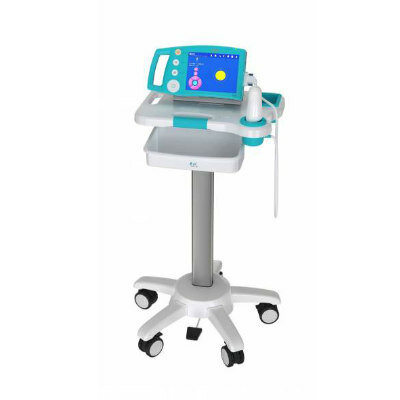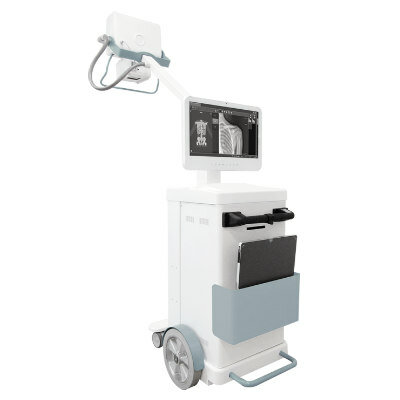Image Analysis Assesses Immune Reaction to Breast Cancer and Improves Treatment
|
By MedImaging International staff writers Posted on 17 Mar 2015 |
A novel test has been developed that can be used to analyze images of “hotspots” where the immune system attacks breast cancer cells.
Scientists used statistical tests to help predict the survival chances of women with breast cancer by assessing the status of their immune system and treated only those in need of intensive treatment. Women with a high number of “hotspots” had a life expectancy of 91 months before their cancer spread while those with fewer hotspots lived 64 months on average.
The scientists analyzed tumor samples from 245 women with estrogen receptor negative (ER negative) breast cancer using computerized imaging and statistical analysis, and measured the number of immune cell hotspots where immune cells were spatially clustered around breast cancer cells. The hotspots were a better indicator of immune response than measuring the number of immune cells in a tumor.
The researchers at the Institute of Cancer Research (London, UK) published details of the test in the February 2015 issue of the journal Modern Pathology.
Team leader in Computational Pathology and Integrative Genomics at the ICR, Dr. Yinyin Yuan, said, “Our research is aiming to develop completely new ways of telling apart more and less aggressive cancers, based on how successful the immune system is in keeping tumors in check. We have shown that to measure the strength of an immune response to a cancer, we need to assess not just how many immune cells there are, but whether these are clustered together into cancer-busting hotspots. By analyzing the complex ways in which the immune system interacts with cancer cells, we can split women with breast cancer into two groups, who might need different types of treatment.”
Definiens (Munich, Germany), which provides image analysis for digital pathology and diagnostics, can discuss what this test means for patients as well as the industry, how this approach is being used in other cancers, challenges with studying the immune system and how they're being addressed, and other advancements expected in immune studies for cancer this year.
Related Links:
The Institute of Cancer Research
Definiens
Scientists used statistical tests to help predict the survival chances of women with breast cancer by assessing the status of their immune system and treated only those in need of intensive treatment. Women with a high number of “hotspots” had a life expectancy of 91 months before their cancer spread while those with fewer hotspots lived 64 months on average.
The scientists analyzed tumor samples from 245 women with estrogen receptor negative (ER negative) breast cancer using computerized imaging and statistical analysis, and measured the number of immune cell hotspots where immune cells were spatially clustered around breast cancer cells. The hotspots were a better indicator of immune response than measuring the number of immune cells in a tumor.
The researchers at the Institute of Cancer Research (London, UK) published details of the test in the February 2015 issue of the journal Modern Pathology.
Team leader in Computational Pathology and Integrative Genomics at the ICR, Dr. Yinyin Yuan, said, “Our research is aiming to develop completely new ways of telling apart more and less aggressive cancers, based on how successful the immune system is in keeping tumors in check. We have shown that to measure the strength of an immune response to a cancer, we need to assess not just how many immune cells there are, but whether these are clustered together into cancer-busting hotspots. By analyzing the complex ways in which the immune system interacts with cancer cells, we can split women with breast cancer into two groups, who might need different types of treatment.”
Definiens (Munich, Germany), which provides image analysis for digital pathology and diagnostics, can discuss what this test means for patients as well as the industry, how this approach is being used in other cancers, challenges with studying the immune system and how they're being addressed, and other advancements expected in immune studies for cancer this year.
Related Links:
The Institute of Cancer Research
Definiens
Latest Imaging IT News
- New Google Cloud Medical Imaging Suite Makes Imaging Healthcare Data More Accessible
- Global AI in Medical Diagnostics Market to Be Driven by Demand for Image Recognition in Radiology
- AI-Based Mammography Triage Software Helps Dramatically Improve Interpretation Process
- Artificial Intelligence (AI) Program Accurately Predicts Lung Cancer Risk from CT Images
- Image Management Platform Streamlines Treatment Plans
- AI-Based Technology for Ultrasound Image Analysis Receives FDA Approval
- AI Technology for Detecting Breast Cancer Receives CE Mark Approval
- Digital Pathology Software Improves Workflow Efficiency
- Patient-Centric Portal Facilitates Direct Imaging Access
- New Workstation Supports Customer-Driven Imaging Workflow
Channels
Radiography
view channel
Novel Breast Imaging System Proves As Effective As Mammography
Breast cancer remains the most frequently diagnosed cancer among women. It is projected that one in eight women will be diagnosed with breast cancer during her lifetime, and one in 42 women who turn 50... Read more
AI Assistance Improves Breast-Cancer Screening by Reducing False Positives
Radiologists typically detect one case of cancer for every 200 mammograms reviewed. However, these evaluations often result in false positives, leading to unnecessary patient recalls for additional testing,... Read moreMRI
view channel
PET/MRI Improves Diagnostic Accuracy for Prostate Cancer Patients
The Prostate Imaging Reporting and Data System (PI-RADS) is a five-point scale to assess potential prostate cancer in MR images. PI-RADS category 3 which offers an unclear suggestion of clinically significant... Read more
Next Generation MR-Guided Focused Ultrasound Ushers In Future of Incisionless Neurosurgery
Essential tremor, often called familial, idiopathic, or benign tremor, leads to uncontrollable shaking that significantly affects a person’s life. When traditional medications do not alleviate symptoms,... Read more
Two-Part MRI Scan Detects Prostate Cancer More Quickly without Compromising Diagnostic Quality
Prostate cancer ranks as the most prevalent cancer among men. Over the last decade, the introduction of MRI scans has significantly transformed the diagnosis process, marking the most substantial advancement... Read moreUltrasound
view channel
Deep Learning Advances Super-Resolution Ultrasound Imaging
Ultrasound localization microscopy (ULM) is an advanced imaging technique that offers high-resolution visualization of microvascular structures. It employs microbubbles, FDA-approved contrast agents, injected... Read more
Novel Ultrasound-Launched Targeted Nanoparticle Eliminates Biofilm and Bacterial Infection
Biofilms, formed by bacteria aggregating into dense communities for protection against harsh environmental conditions, are a significant contributor to various infectious diseases. Biofilms frequently... Read moreNuclear Medicine
view channel
New SPECT/CT Technique Could Change Imaging Practices and Increase Patient Access
The development of lead-212 (212Pb)-PSMA–based targeted alpha therapy (TAT) is garnering significant interest in treating patients with metastatic castration-resistant prostate cancer. The imaging of 212Pb,... Read moreNew Radiotheranostic System Detects and Treats Ovarian Cancer Noninvasively
Ovarian cancer is the most lethal gynecological cancer, with less than a 30% five-year survival rate for those diagnosed in late stages. Despite surgery and platinum-based chemotherapy being the standard... Read more
AI System Automatically and Reliably Detects Cardiac Amyloidosis Using Scintigraphy Imaging
Cardiac amyloidosis, a condition characterized by the buildup of abnormal protein deposits (amyloids) in the heart muscle, severely affects heart function and can lead to heart failure or death without... Read moreGeneral/Advanced Imaging
view channel
New AI Method Captures Uncertainty in Medical Images
In the field of biomedicine, segmentation is the process of annotating pixels from an important structure in medical images, such as organs or cells. Artificial Intelligence (AI) models are utilized to... Read more.jpg)
CT Coronary Angiography Reduces Need for Invasive Tests to Diagnose Coronary Artery Disease
Coronary artery disease (CAD), one of the leading causes of death worldwide, involves the narrowing of coronary arteries due to atherosclerosis, resulting in insufficient blood flow to the heart muscle.... Read more
Novel Blood Test Could Reduce Need for PET Imaging of Patients with Alzheimer’s
Alzheimer's disease (AD), a condition marked by cognitive decline and the presence of beta-amyloid (Aβ) plaques and neurofibrillary tangles in the brain, poses diagnostic challenges. Amyloid positron emission... Read more.jpg)
CT-Based Deep Learning Algorithm Accurately Differentiates Benign From Malignant Vertebral Fractures
The rise in the aging population is expected to result in a corresponding increase in the prevalence of vertebral fractures which can cause back pain or neurologic compromise, leading to impaired function... Read moreIndustry News
view channel
Bayer and Google Partner on New AI Product for Radiologists
Medical imaging data comprises around 90% of all healthcare data, and it is a highly complex and rich clinical data modality and serves as a vital tool for diagnosing patients. Each year, billions of medical... Read more



















